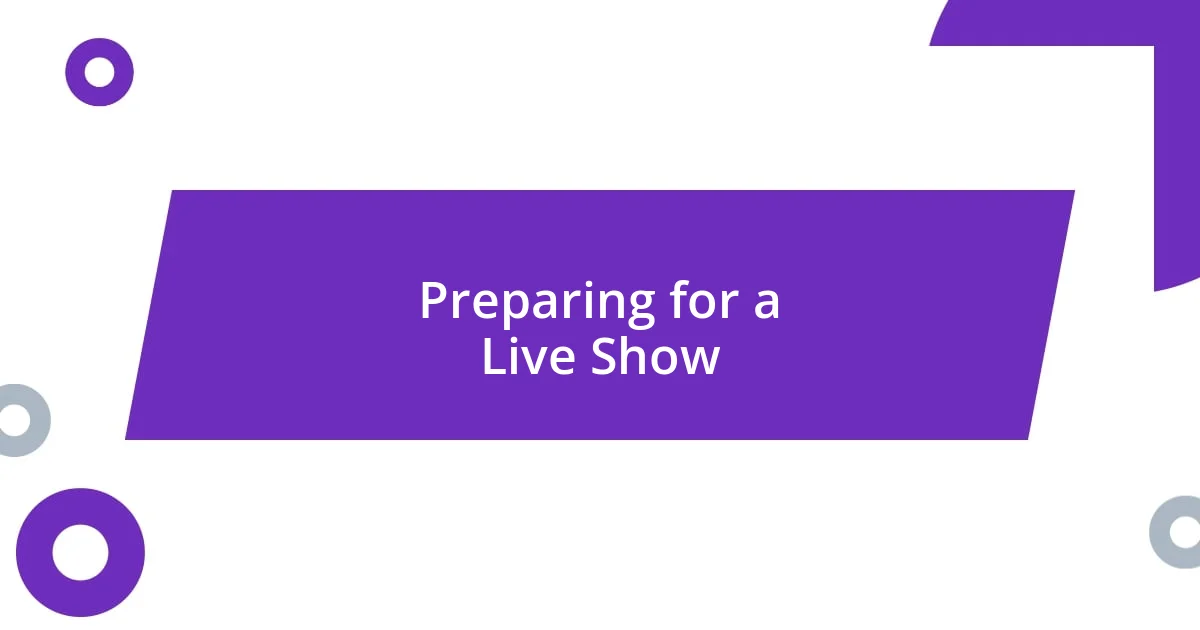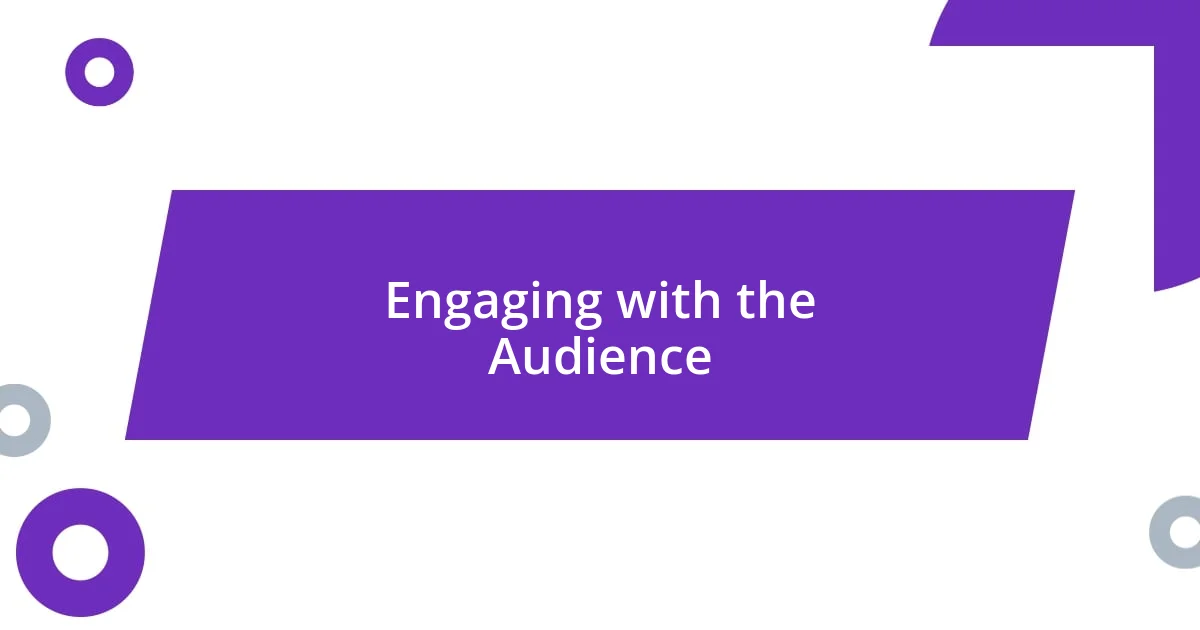Key takeaways:
- Audience connection is crucial; effective engagement techniques like eye contact, participation, and storytelling create a shared experience.
- Thorough preparation is key; utilizing checklists for rehearsal, gear checks, and mindset strategies enhances performance readiness.
- Continuous improvement through performance analysis and feedback helps artists grow, enabling them to replicate successful moments and learn from mistakes.

Understanding Live Performance Essentials
Understanding the essentials of live performance is truly about connecting with the audience on a deeper level. I remember one time during a small acoustic set, the quiet anticipation in the room felt electric. Have you ever felt that moment when you’re waiting for the first note? It’s like the world pauses, and all eyes are on the performer.
One critical component is the artist’s presence. I once saw a performer who had a magnetic stage presence that drew everyone in. It made me wonder: how can one person command such attention just by being themselves? That sense of authenticity not only captivates but also creates a shared experience with the audience, making everyone feel like part of something special.
Great live performances are also about the atmosphere—lighting, sound, and energy blend together to create a unique experience. I vividly recall a concert where the lights synchronized perfectly with the music, sweeping the audience into a euphoric state. It’s fascinating to think about how much these elements influence our emotional responses. When was the last time you felt completely immersed in a moment like that?

Preparing for a Live Show
Preparing for a live show involves meticulous planning to ensure everything runs smoothly. I remember the thrill of unpacking my gear and going over the set list one final time. There’s a unique excitement in those moments, as if I’m about to step into a world where anything can happen. It’s about balancing adrenaline with preparation, making sure I’m ready both mentally and physically.
Here’s a checklist that can help streamline your preparation:
- Rehearsal Time: Set aside ample time to run through your performance multiple times.
- Gear Check: Ensure all equipment is functioning properly—don’t wait for the show to find out!
- Set List Order: Organize your songs thoughtfully to create a flow that keeps the audience engaged.
- Warm-Up Routine: Develop a vocal and physical warm-up routine to get in the right mindset.
- Mindset Preparation: Spend a few moments visualizing your performance as a success—this mental rehearsal can do wonders for confidence.
- Logistics: Plan your arrival time, know the venue layout, and have a backup plan for any possible mishaps.
- Stay Hydrated: Keep water on hand; it’s a small but vital detail that often gets overlooked.
By focusing on these elements, I ensure that I’m not just prepared but also able to connect on a deeper level during the show. Each performance becomes a shared journey, one that starts long before I step onto the stage.

Engaging with the Audience
Engaging with the audience is an art form that transforms a performance into a shared journey. I’ve experienced the power of eye contact; locking eyes with someone in the front row can create an intimate connection. It’s as if we’re having a private conversation amidst the crowd. Have you ever noticed how a simple smile from the performer can uplift an entire room? This interaction fosters a sense of belonging that is magical.
In my experience, incorporating audience participation can elevate the performance. One time, I asked everyone to clap along during a chorus, and the energy shifted dramatically. The initially shy crowd suddenly became a lively sea of rhythm and voices. Comparison is key here: engaging an audience is like cooking—without the right ingredients, you may end up with a bland dish. When the audience is part of the experience, the performance becomes so much more flavorful.
Lastly, storytelling adds depth to a live show and helps humanize the performer. I remember sharing a personal story behind a song that resonated deeply with my listeners. Their response was palpable; I could see the empathy in their eyes, and it felt as though we were intertwined in that moment. It’s this emotional exchange that truly enriches any live performance, reminding us that we’re all in this together, experiencing something meaningful.
| Engagement Techniques | Example Experiences |
|---|---|
| Eye Contact | A moment when my eyes met a fan’s and everything else faded away. |
| Audience Participation | When I got the crowd to clap along, it transformed the atmosphere into something electric. |
| Storytelling | Sharing the backstory of a song created empathy and a deeper connection. |

Effective Use of Stage Presence
Stage presence is about more than just being seen; it’s about commanding the space around you. I vividly recall the first time I stepped onto a stage and felt all eyes on me. It was exhilarating yet nerve-wracking. But I quickly learned that owning the space—through confident posture and purposeful movement—can draw the audience in. Have you ever noticed how a performer who fills the stage with energy instantly captivates your attention? It’s a magnetic quality that can transform the atmosphere.
Another lesson I’ve discovered is that subtlety can be just as impactful as grand gestures. I remember a moment during a quiet ballad when I chose to stand still, letting the emotion in the music wash over the audience. That stillness allowed everyone to pause, to breathe, and to truly feel the moment. It’s fascinating how sometimes the simplest actions can evoke the strongest reactions; that collective silence can create a bond between performer and audience that’s electric.
Lastly, integrating movement with intention can amplify your message. During one performance, I chose to step forward during a powerful lyric, embodying the message behind the song. It was as if I was inviting my audience to join me in that moment of vulnerability. The connection felt palpable, as if we were sharing a secret. In my experience, it’s essential to remember that every movement counts, and when they resonate with the content, they make the experience unforgettable. What moments have you felt most connected to a performer?

Managing Performance Anxiety
Managing performance anxiety is a challenge I’ve faced time and again. One effective strategy I’ve found is breathing exercises. Before I step on stage, I take a few deep breaths to center myself. Have you ever tried that? It’s remarkable how something so simple can quiet the noise in your head and bring focus back to the moment.
Visualization is another tool I rely on. I imagine the performance going smoothly, the audience engaged and enjoying every minute. This mental rehearsal not only boosts my confidence but often leads to a more enjoyable performance. It’s almost like creating a personal atmosphere where I can thrive. Have you noticed that a positive mindset can change your experience significantly?
Additionally, embracing vulnerability has liberated me from the grips of anxiety. When I tell myself it’s okay to feel nervous, I’ve noticed a shift in my perspective. I recall a night when I opened up to the crowd about my fears just before I played a new song. Instead of feeling judged, I felt an overwhelming sense of support. It’s this openness that helps forge a connection, reminding me—and perhaps you too—that we’re all human and share similar struggles. Don’t you think that acknowledging our fears can actually empower us?

Enhancing Technical Skills
Enhancing technical skills is an ongoing journey that I’ve found requires both dedication and creativity. During my early days in performing, I remember investing countless hours in practicing my instrument, often feeling frustrated when I couldn’t nail a tricky passage. Yet, with each attempt, I discovered that patience becomes a powerful ally. Have you ever felt that moment when things finally click? It’s as if all your hard work has culminated in a breakthrough that boosts your confidence.
Every time I tackled a new piece, I made it a point to break it down into manageable sections, focusing on one small segment at a time. This method not only streamlined my learning process but also allowed me to see progress in real-time. One evening, I decided to film myself playing, and though it felt odd at first, watching the playback helped me identify areas for improvement that I hadn’t noticed before. Have you tried recording your performances? It can be a game-changer!
Moreover, seeking feedback from fellow musicians has enriched my skillset immensely. I recall a jam session where a more experienced player pointed out a few subtle techniques I hadn’t considered. They suggested varying my dynamics to enhance emotional expression, and it opened a whole new world for me. Isn’t it fascinating how collaboration can illuminate aspects of our artistry we might overlook? I believe creating a supportive community not only hones our skills but also inspires us to reach new heights together.

Learning from Each Performance
Each performance teaches me something new, and I’ve learned to embrace that process. After a show, I often sit down and reflect on what went well and what didn’t. I remember one particular gig where I missed a cue, which initially felt devastating. But later, I realized that it became a pivotal moment; acknowledging my mistake helped me strategize how to prevent it in the future. Do you take time to analyze your experiences? I find it’s essential for growth.
I’ve also discovered that audience feedback can be a treasure trove of insights. One evening, after performing, I had a heartfelt conversation with a fan who shared how a specific song resonated with their personal journey. Hearing that made me recognize the impact of my artistry, turning what seemed like just a performance into a meaningful connection. Can you recall a time when an audience member’s response changed your perspective? For me, those moments remind me that our work reaches far beyond the stage.
Finally, I often jot down notes right after a show; it’s incredible how details can slip away quickly. I recall one night when I felt especially connected to the crowd. The energy was electric, yet the details of that connection faded by the next morning. Writing about it allowed me to capture that feeling, helping me replicate it in future performances. Have you ever thought about documenting your experiences? I believe these reflections not only solidify lessons learned but also act as inspiration for our next act.














